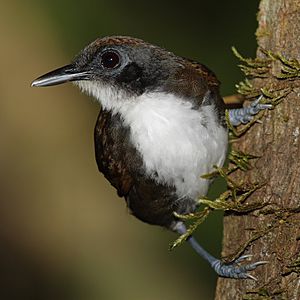Ant-follower facts for kids

Ant-followers are special birds that get their food by following groups of army ants. These birds do not eat the ants themselves. Instead, they catch insects and other small creatures that try to escape from the ants. It is like the ants are flushing out dinner for the birds! Many different kinds of birds can be ant-followers, including some antbirds and cuckoos.
Contents
Ant-Followers: Birds That Follow Ants
What Are Ant-Followers?
Ant-followers are birds that have a clever way to find food. They follow swarms of army ants as the ants march through the forest. Army ants are known for hunting in large groups. As these ants move, they scare away many small animals like spiders, cockroaches, and lizards. These animals try to run from the ants. This is where the ant-follower birds come in. They wait nearby and snatch up these fleeing creatures. It is a smart partnership where the birds get an easy meal.
Why Do Birds Follow Ants?
Birds follow army ants because it is an efficient way to find food. Hunting for insects and other small animals in a dense forest can be hard work. By letting the ants do the "hunting" part, the birds save a lot of energy. They just need to be quick enough to catch the prey that escapes the ants. This method is especially helpful in places where food might be scarce or hard to find. It is a unique hunting strategy that shows how animals adapt to their environment.
Types of Ant-Followers
There are many different kinds of birds that follow ants. Some birds are "obligate" ant-followers. This means they almost always get their food by following ants. A good example is the Bicoloured Antbird, which is part of the antbird family. These birds are very specialized.
Other birds are "facultative" ant-followers. This means they follow ants sometimes, but they also find food in other ways. Many different bird families have facultative ant-followers. These include some cuckoos, woodcreepers, and even some tanagers. This shows that following ants is a successful strategy for many types of birds.
The Role of Army Ants
Army ants are crucial to this relationship. They are powerful predators that hunt in huge colonies. A single colony can have millions of ants. When they march, they form a wide front, sweeping through the forest floor. This movement creates a lot of disturbance. It is this disturbance that makes prey run, creating opportunities for the birds. Without these large, hunting ant colonies, ant-follower birds would not have their unique food source. The ants do not seem to mind the birds. They are focused on their own hunt.
Benefits for the Birds
The main benefit for ant-follower birds is a steady supply of food. They do not have to spend time searching for hidden insects. The ants bring the food to them, in a way. This also means the birds can spend more time on other important activities, like raising their young or defending their territory. It is a very efficient way for these birds to survive and thrive in their habitats.
See also
 In Spanish: Ave seguidora de hormigas para niños
In Spanish: Ave seguidora de hormigas para niños

